A Girl and Her Goggles: Tips for Writing Steampunk
 By Sarah Noé, Guest Contributor
By Sarah Noé, Guest Contributor
In April, we were honored to feature Sarah’s post, When Words Stop Coming, in which Sarah talked about her new writing project, a light steampunk novel. We asked Sarah to tell us more about what it’s like to write in the steampunk genre.
I couldn’t tell you when I initially heard the word “steampunk,” but I know my journey into this science-fiction subgenre started with Jane Austen.
I first read Pride and Prejudice in middle school with my mom for literature class (former homeschooler here!). I distinctly remember that the long sentence structure took some getting used to. However, I instantly fell in love with the characters, the twists and turns of Elizabeth Bennett and Mr. Darcy’s romance, and the witty prose that flowed effortlessly from Austen’s pen.
Being a voracious reader, I was quick to plow into all the other Austen novels. The part that hooked me on the Regency Era most of all…was the BBC costume dramas. Suddenly the bustling city streets, the crowded ballrooms, and the sprawling English countryside were there, before my eyes. I drank it all in; I memorized the recurring names of actors in the costume drama circuit. I learned to imitate the various British dialects.
By this time, Charles Dickens had entered stage left. The Victorian Era became my new favorite part of history. The size of many Dickens novels was intimidating. Nonetheless, I could manage Oliver Twist, A Tale of Two Cities, and A Christmas Carol. I was in high school now and somewhere in my writing adventures, the word “steampunk” surfaced. The look of airships, Victorian fashion, goggles, grease, and complicated clockwork designs was fascinating! Anything could exist in such a world if it was steam-powered. Besides, what’s not to love about the mash-up “Victorian Era meets sci-fi”?
It might sound like I had all the pieces in place, all the gears turning, for a happy steampunk writing career. However, the sub-genre still held some surprises for me—surprises I want to impart to you. I hope by sharing them that steampunk will appear more accessible if you, too, have an interest in writing it.
I didn’t begin an earnest search into the genre until my final years of college. To my dismay, I realized that steampunk was largely a visual, not literary genre. While clockwork animals and elaborate dresses were cool to look at, I couldn’t seem to find any decent steampunk books. If they weren’t dull, they were full of clichés or dirty content. I was also dismayed to find that steampunk, unlike other genres, does not truly have a “standard” or “pillar” work.
These discoveries took me aback.
Since I found nothing in my search to inspire me, I wrote a couple of scenes dabbling in my own notion of the genre: teatime, highbrow names, an airship, a Cockney mechanic…it was fun. I saved the file to my computer and moved on to other projects.
When I came around to the idea a few years later, I found myself drawn to the historical thread of steampunk. Everyone focused on the technology (which was undoubtedly impressive) but it was the class structure, the clashes in hierarchy, and the larger-than- life characters in the Victorian era that I wanted to write about, and that had first drawn me to Austen and Dickens. Steampunk, with one foot in history, had the potential for great stories about these themes.
It quickly became clear to me that I had to do the one thing I wasn’t wild about: research. My younger, more naïve self thought that with steampunk, I could just make things up. It wasn’t really historical fiction. Who cared about titles or whether Lord Summertree would ever be in the same place as Nan the factory girl? However, the Victorian Era was a time defined by its classes and the unspoken rules that held them apart. These were necessary to keep the society together as a whole. Even if my world were fictional, it would be strongly influenced by that era. I wanted to make sure I got my basic facts straight.
This realization felt like a hindrance, but it pushed me to invest more thought and creativity into my project—and it can push you too.
Fortunately, I didn’t have to go far to find information. The Internet provided some useful websites and the library furnished several fascinating non-fiction books. There was so much to learn about the types of carriages, the way titles were assigned, and so many more things than I needed for my story. I also continued to read fiction set in that time period. (I’m happily creeping through Our Mutual Friend by Dickens right now—which I highly recommend.)
Armed with what I learned and with examples in classic literature, I then just set about trying to craft a compelling story, using the lessons I’d picked up from The One Year Adventure Novel, other writers, and my own personal study.
If you are considering steampunk or other hybrid genres, don’t be afraid to lean into the technical or historical elements. Sure, it’s fun to imagine new places and new things that no one’s ever heard of. For a unique twist in my own novel, I added a fantasy element where dragons and unicorns roamed the forest in bygone days…and might still. Nevertheless, don’t underestimate the richness that real-life historical details can bring to your story world. On a humorous note, I discovered that Victorians had some fantastic slang back in the day. To be “blue as megrim” was to be sad or depressed. Or my personal favorite: if someone is “smelling of April and May,” they are madly in love! In terms of the plot, you never know what conflicts and subplots can spring from lesser-known facts, like the difference in wage between a steward and a footman.
I can tell you firsthand that leaping from a casual fascination to confidence in your craft is daunting. The Internet is overflowing with visual inspiration for unique genres, but literary signposts are often lacking for the way of a writer. Nonetheless, I like to think that my journey illustrates how far passion and a willingness to explore can take you. If you love steampunk, there are so many directions in which the genre could grow. The skies are wide open. So strap on your goggles and roll up your sleeves. With a little elbow grease of research, your story can sail far.
…
Have you ever wanted to write steampunk? If you tried it, how did it go?
…
Music and Story have been a part of Sarah’s soul since childhood. She had the great privilege of taking The One Year Adventure Novel live in 2009 as part of the “Brightoneers” class. She also studied Piano Performance at the UMKC Conservatory of Music and currently works as a freelance accompanist. Sarah fills her spare time with handicrafts, nerdy TV shows, reading, and writing her steampunk novel. Over the years, she has been incredibly blessed by her time in the OYAN community and is thrilled to be back online as a forum Mentor, under the name of “Pippin.”




This is a really fabulous post, Sarah! I’m fascinated by steampunk for concept’s sake, but I’ve never particularly had a desire to write it. Your tips about mixed-genres in general, though, really interest me. I know that feeling of hating research, too. But it’s amazing what depth it creates. I’m discovering that with my current project.
I look forward to reading your story someday!
Thanks, Rachelle! I’m happy to hear you enjoyed it. History is a fascinating subject all on its own, but I’ve really come to appreciate its influence into fiction within the past few years. As you mentioned, it can bring so much depth to the story.
And thank you, I’m excited to share my story once it’s ready!
What kind of project are you working on? Is it historical or more speculative fiction?
Yeah, I really love history. Though, for some reason, I hate research… I think what I actually dislike is the stress of making sure I get things right.
My current project is fantasy, but it’s not really classical fantasy. It’s more like Greek-inspired tech-fantasy, if that makes sense. I’ve had fun researching Greek clothing, especially, but I’m also intending to incorporate architecture and food.
Yes, I think worry over getting things right and feeling overwhelmed by all the information are the big bogey monsters of research for me.
Your book sounds fascinating! I haven’t read much Greek-inspired fiction, but I’m always up to try something new when it comes to fantasy and sci-fi. Have you posted anything about this on the forum?
My first OYAN novel was subtle steampunk. I wanted to incorporate the visuals I loved but also make them practical and pertinent to the story. I would like to come back to that story, flesh it out, research a ton more, and re-work the characters. I’m encouraged to think that the realm of steampunk is uncharted. The opportunities are endless!
Absolutely, Catherine! That’s what excites me about the mixed genres, like steampunk.
If you do come back to that story you mentioned, and would like some help or research suggestions, send me a message on the forum! I’m happy to share some of the resources I’ve discovered. 🙂
As a fellow steampunk writer, I cannot applaud this post enough! I’m in the same boat right now, putting in the research time it takes to create a world that feels real–even if it’s fantasy. Many authors find this daunting, but in the end, it really does pay off. Thanks for an excellent read!